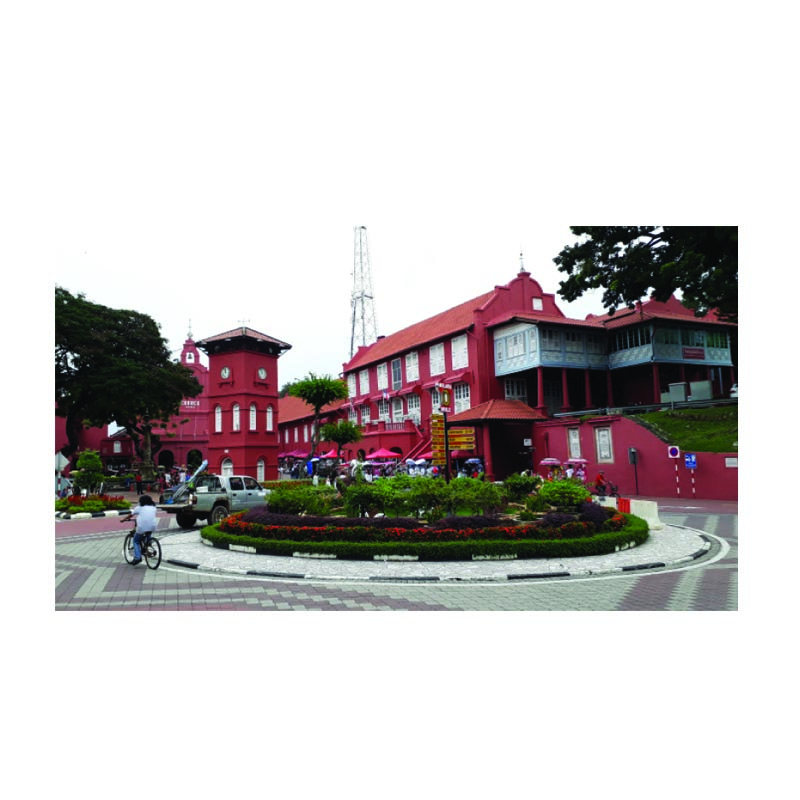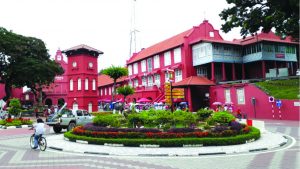
I first heard of Malacca from the stories about Admiral Zheng He’s expeditions across Asia and Africa. When my traveling companions invited me to join them for a trip to Malaysia, I suggested a side trip to this intriguing city. From the Kuala Lumpur International Airport, we traveled 142 kms southwest for two hours to this port city which reminds me of my childhood days in Binondo in the 1960s and early 1970s.
Historic Malacca
Malacca (馬六甲) or Melaka in Malay, a tiny fishing village located in the southern part of the Malay Peninsula, is described as the “Historic State” of Malaysia. Its capital, Malacca City, is the oldest Malaysian city along the Straits of Malacca.
Malacca was founded by Parameswara, a royal prince from Palembang of Sumatra. After a Majapahit attack in 1377, he found his way to Malacca around 1400. His decision to set up a state here was a wise one since Malacca was a good port: it is situated at the narrowest point of the strait, and served as a strategic port for ships waiting for the monsoon rains to pass or for resupplying of trading ships plying the East-West route.
Chinese Muslim Admiral Zheng He (鄭和 1371-1433) and his fleet stopped by Malacca five out of his seven voyages from 1403 to 1435, leaving tools, implements and Chinese wares. Chinese settlers followed and intermarried with the local Malays. Their descendants were known as Baba (峇峇 for male) and Nyonya (娘惹 for female), collectively referred to as Peranakan Chinese or Straits-born Chinese (土生華人).
After the rule of the Malacca Sultanate in the 15th century, Malacca was successively under the control of the Portuguese in 1515, Dutch in 1641, British in 1824 and Japanese in 1942, before becoming part of the Federation of Malaysia in 1963. Thus, we see a rich mix of cultural influences of these countries in their architectural styles and cuisine.
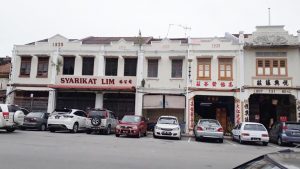
Streets of Malacca
The best way to experience Malacca is on foot. Fortunately the Majestic Malacca Hotel where we stayed offered a complimentary two-hour guided tour. Our guide, Rahayu, started with a short history of the hotel, which used to be the house of a Chinese merchant. On our way to the Chinatown area, we passed by food stalls, shops selling clothes, shoes, books and Chinese décor items.
The first prominent stop was the Wholesale Street (Jalan Kampung Pantai) where, as the name implies, wholesale stores abound. The buildings have the year they were built etched on top of the doors, with Chinese store signs in front and on the two adjacent posts. The steel gates were vintage accordion type. They reminded me of the same features in Binondo stores in the 60s where every store had a Chinese name. Where our Chinese store names were painted on the posts, some of the Malacca signs were embossed or carved. Wholesale Street used to be the commercial center, but because of rental increase, some buildings are now deserted. The two-storey buildings have narrow frontage and extend to the back street. This is because property tax was based on the width of the building’s frontage.
In a narrow street, we saw art works painted by local artists on the walls. This is Tofu Street (Jalan Hang Kasturi), named after the tofu-based snacks sold here. A row of Peranakan houses with distinctive colorful façades greeted us. One immediately noticed the conservation and restoration efforts done on these buildings. Some facades are still original, according to guide Rahayu. Many of these houses have now been converted to budget hotels, restaurants, souvenir shops while others still maintain the old family business, selling tin kitchen utensils, bamboo baskets, stylish slippers, carved signage and other household needs.
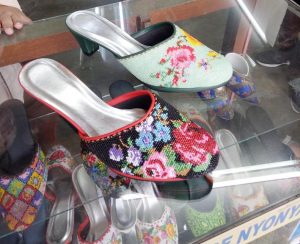
On the way to our next stop, we dropped by TS Lim Trading on Jalan Tokong, a store selling hand-sewn Nyonya beaded shoes owned by Lim Tian Seng. On display in the store was a pair of 100-year-old Nyonya beaded shoes. We chanced on the wife, Sue, designing a new pattern, very similar to a cross-stitch pattern. The actual sewing may take at least three days of eight hours’ work, even for a simple pattern, because the beads are really small. The shoes with classic beads cost RM255 while tiny beads which are half the size of the classic beads can fetch more than RM1,000 depending on the intricacy of the design. Asked about successors to this dying trade, Lim shared that his children are not interested, as it is easier to work in the city than mastering the skill of bead sewing.
Harmony or Temple Street is a long curved street and has many local names: Jalan Tukang Emas, Jalan Tukang Besi and Jalan Tokong. One can find a Muslim mosque, Hindu and Buddhism temples all on this one street.
Kampung Kling Mosque, the oldest mosque in Malacca, was originally a wooden building in 1748 and rebuilt in brick in 1872. The architectural design is a cross of Hindi, Chinese and Malay. Some of the English and Portuguese glazed tiles are still original while broken pieces have been replaced with reproductions.
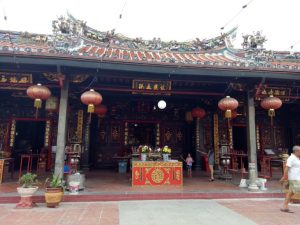
Next to the mosque is Cheng Hoon Teng (青雲亭 Temple of Green Cloud), the oldest functioning temple in Malaysia that practices Buddhism, Taoism and Confucianism. It was built in 1645 by Chinese Kapitan Lee Wei King with materials imported from China. Later Chinese Kapitans built the other parts of the temple. The main prayer hall is dedicated to the goddess of mercy, Kuan Yin. A seven-meter red flagpole on the left wing of the main prayer hall faces the grave of two of the three Kapitans who contributed to the construction of the temple. This temple was the Hokkien community’s main place of worship. Note that the English name of the temple is transcribed from Hokkien.
Across Cheng Hoon Teng is a newer two-storey Buddhist temple, Xiang Lin Si (香林寺). This temple follows Mahayana Buddhism. The second floor offers a nice vantage point of the neighboring temples.
We passed by Sri Poyatha Moorthi Temple, the oldest Hindu temple but did not go in. This temple is one of the few existing Chitty (Indian Peranakan) temples in Malaysia. These temples have co-existed harmoniously for centuries on this street.
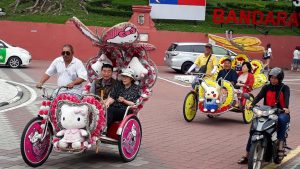
During the entire walk, one cannot miss the multi-colored trishaws plying the streets. The bicycle rickshaws are decorated with flowers, vibrant designs and flashing lights that glow at night, with accompanying loud blaring of Chinese, Western and Malay pop songs. These groovy trishaws can take you around the city center with the driver acting as the guide. The most attractive one I saw was a pink trishaw decorated with Hello Kitty!
The tour ended at the Red Square or Dutch Square. The square is surrounded by red painted buildings like the Stadthuys City Hall, the oldest colonial Dutch structure, and St. Christ Church beside it. There are many of points of interest in this square like museums, cathedrals, historic sites.
Jonker Street night market
Jonker Walk along Jonker Street (Jalan Hang Jebat) is the central street of Chinatown in Malacca. The street is well known for its antique shops, clothing outlets, pubs, coffee shops, restaurants and museums. Some interesting items that caught my attention were a circular abacus and an oval auspicious wedding basket. But what brought back childhood memories were the Chinese tiffin carriers (enamel-painted layer lunch box or pombrera) in different sizes, shades, designs and layers. What we used when we were kids were white or blue colored.
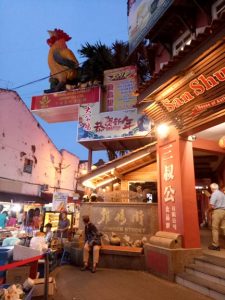
We were quite fortunate to arrive on a Sunday, in time for the weekend pasar malam (night market). In the middle of Jonker Street are hundreds of stalls selling a diversified mix of goodies – from food to souvenirs to fashion items. Some interesting and tempting food items were the watermelon handbag, fried ice cream, chicken rice ball, Nyonya laksa and varieties of dimsum. And for the tired feet, there are stalls that offer foot massage.
At the end of Jonker Street is a stage for seniors to perform karaoke songs, mostly in Mandarin, Cantonese and Hokkien. There are rows of seats in front of the stage for the audience. Tourists, especially the Caucasians, were taking videos of the performances, unmindful of the often off-tempo or out of tune singing. I bought myself a cup of strong Kopi O in a nearby eatery while getting entertained by this amusing scene.
City of museums
For a small city, Malacca has at least 35 museums. Wow! We had time to visit a few before closing time so I took charge and selected two museums to visit.
First was the Baba Nyonya Heritage Museum (峇峇娘惹博物館) located along Jalan Tun Cheng Lock, which offers scheduled guided tours. This museum showcases the house the Chan (曾) family acquired in 1861. The house is made up of three lots; two used by the owners and one used as servant quarters. Four generations of Chans lived here before it was converted into a museum in 1985. The tour starts from the reception hall, to the bedrooms, dining room, ancestral hall and kitchen, depicting the lifestyle of the Peranakans.
The other is a museum about Zheng He. The Cheng Ho Cultural Museum (鄭和文化館), located on Jalan Kota, is the largest museum in Malacca. The exhibit starts with a short film about the life of Zheng He and his world voyages. The building is believed to be the warehouse complex built by Zheng He to temporarily store goods he acquired during the voyages. An interesting segment was the timeline showing Zheng He’s exploration even before Vasco da Gama, Christopher Columbus and other explorers.
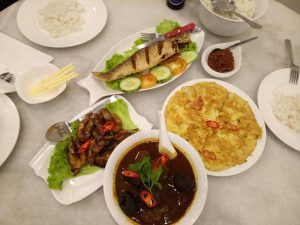
Food haven
Food in Malacca is diverse. We tried to get a taste of the different varieties Malacca has to offer. We chose Manis J Nyonya Restaurant on the day we arrived. The owner, Jimmy, was very accommodating and helped us with our orders. We were served complimentary keropok (shrimp crackers).
We tried their Crispy Fried Fish with Nyonya chili sauce, sambal petai udang (chili prawns), ayan buah keluak (a house specialty of stewed chicken with black nuts called buah keluak). Jimmy even demonstrated how to dig out the fruit in the buah keluak which has a bitter earthy aftertaste, but the stew sauce goes very well with white rice after you get the hang of it. My favorite is their omelet with fermented baby shrimp (telur dadar cincaluk). It was so good and tasty, we had seconds.
For dessert, we ordered sago pudding and cendol, an iced sweet dessert with green rice flour jelly. Both were sweetened with gula melaka, dark palm sugar syrup. Food on the Manis J menu are home recipes of Jimmy’s mother, Mama Nai, so expect authentic Nyonya home cooking. Prices though are not that cheap, maybe because this is one of the few restaurants with air-conditioning. We were too stuffed after Manis J to taste the street food on Jonker Walk. But before we left this food haven, we couldn’t resist getting a bite of their grilled shellfish, mainly razor clams and giant scallops.
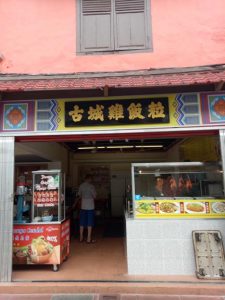
We also tried the famous Hainanese chicken at Restoran Famosa Chicken Rice Ball (古城雞飯粒) in Chinatown area. We had soy chicken, fish ball soup, meat ball soup, asado and sautéed preserved mustard greens. Food is passable but nothing to rave about. They have more than one branch in the area.
While waiting for our Baba Nyonya tour to start, we were attracted to a Peranakan house on the same street called The Baboon House. The doors were locked and you have to press a buzzer before being let in.
The café is situated at the courtyard portion of the house. If you are looking for a quiet cozy place to have afternoon coffee or read a book, this quaint café is the place to go. The ambience is rustic and surreal. Whether it’s the iced lemongrass ginger tea or the aromatic coffee coupled with delicious pastries, the food perked us up for the museum tours. We later discovered that Baboon House is known for their gourmet hamburger. Another reason to come back.
On our way to the hotel from our museum tour, we chanced on an eatery with many local customers. The phrase, “When in Rome, do as the Romans do,” quickly came to mind. Restoran Sin Yin Hoe (新雲河茶餐室) offers Hokkien cuisine. We ordered misua guisado, three-cup chicken, fried soft shell crab, sautéed beansprout and a local fish cooked with tauso. The food tasted better than they looked but is quite expensive for a non-air-conditioned eatery.
Along the streets of Chinatown are stalls and eateries selling popiah (lumpia), yu char kuey (Chinese churros or bicho), char kuey teow (stir-fried rice cake strips) and Nyonya laksa. One eatery beside our hotel, the Mei Sin Café, always has long queues of people in the evenings even after the main café has closed. We didn’t want to miss the Kristang (Malacca-Portuguese) cuisine but time was tight as we wanted to try the Portuguese restaurants in Jalan Daranjo near the beach side. So we decided to try it at the Melba at the Mansion in our hotel.
Kristang cuisine is characterized by sambals, coconut curry and tangy flavors. The Karing Karing Fretu is an interesting appetizer of fried silver threadfish and goes well with beer. For main courses, our server’s recommendations were baked stuffed crabs with vegetables, chicken and prawn stuffings (Inchimintu Karangezu), pan fried aubergine in soy and lime sauce (Soy Limang Terung), slow-cooked squid in squid-ink sambal (Papa Vincent’s Chorka Pretu), baked sea bass fillet in lemongrass and kaffir lime leaf sauce (Asa).
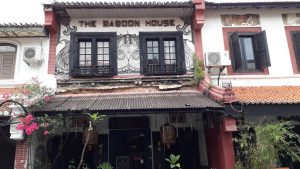
With so much variety on the menu, things got out of hand. We added fried rice with fermented shrimps and vegetable (Cincalok Fretu), braised chicken in shallots and fermented bean gravy (Pong Teh) and beef stew cooked in vinegar with onions and potatoes (Semur). Definitely a lot of rice to go with these food.
See you again, Malacca
Malacca was listed as a UNESCO World Heritage Site in 2008. There are still many unexplored attractions in Malacca that we need to discover. A three-day/two-nights stay is barely enough time to explore this vintage and classic city. We just hope that more stores will open and be converted to establishments to keep this town alive. Without doubt, this fascinating port deserves a second visit.
Tsinoys who speak Hokkien and Mandarin will feel right at home because there is an instant feeling of attachment to this place and its people. For a laidback, leisurely place to visit, Malacca is the perfect spot.
